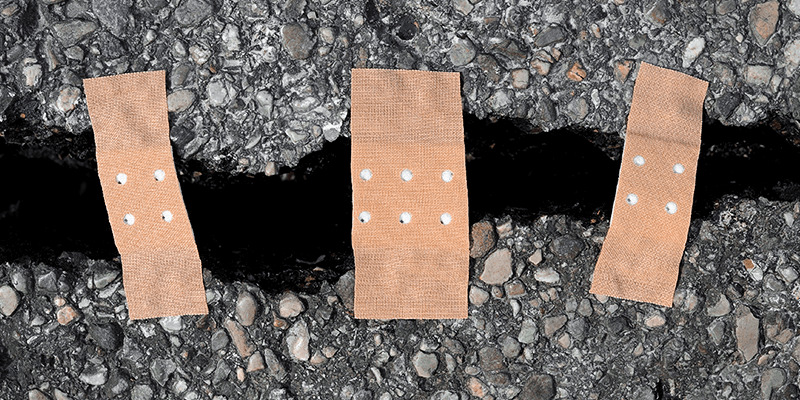Was ist Bitumen?
Bitumen ist ein Produkt, das bei der schonenden Aufbereitung von Erdöl entsteht. Es kommt jedoch auch in Naturasphalt oder in natürlichen Bitumenvorkommen (Naturbitumen) vor. Das wohl bekannteste Vorkommen ist der Pitch Lake auf der Insel Trinidad. Dort sprudelt flüssiges Bitumen aus dem Untergrund heraus.
Der Hauptbestandteil von Bitumen ist langkettiger Kohlenwasserstoff. Zusätzlich lassen sich Schwefel, Sauerstoff, Stickstoff und Spuren von Metallen in dem Baustoff finden.

Welche Eigenschaften hat Bitumen?
Der Baustoff ist kaum flüchtig, klebrig und wirkt abdichtend.
Es gehört zu den thermoplastischen Stoffen, weshalb es sich temperaturabhängig elastoviskos verhält. Bei Abkühlung wird es spröde, bei Erwärmung durchläuft es stufenlos alle Zustände von fest über zähflüssig bis dünnflüssig. Bei steigenden Temperaturen fängt es an, sich langsam zu zersetzen.
Ebenso wird es spröde und rissig, wenn es dauerhaft der Witterung ausgesetzt ist und die Oxidationsvorgänge das Material beschädigen. Durch die Beimischung von Kunststoffen, schwächen die temperaturabhängigen Eigenschaften ab.
Durch die Eigenschaften des Bitumens lässt sich der heiße Asphalt bei Straßenbaustellen leicht schütten, verteilen und glätten. Danach wird das Gemisch schnell fest. Jedoch ist darauf hinzuweisen, dass sich diese Eigenschaft von normalen Bitumen an Hitzetagen als nachteilhaft erweist, da die Asphaltdecke aus der Form geraten kann. Hinsichtlich des Recyclings ist dies jedoch ein immenser Vorteil, da das Material nur erhitzt werden muss und danach zur erneuten Verarbeitung bereit ist.
Bitumen ist nicht in Wasser löslich, weshalb Lösemitteln wie Toloul, Trichlorethylen, Tetrachlorethen (Perchlorethylen) oder Dichlormethan (Methylenchlorid) zum Einsatz kommen.
Wo wird das Bindemittel eingesetzt?
Da der Baustoff wasserabweisend ist, wird er verwendet, um empfindliche Stoffe und Bauteile gegen Wasser zu schützen. Nachfolgend sind konkrete Einsatzfelder aufgelistet:
- Straßenbau (als Bindemittel in Asphalt und insbesondere in Gussasphalt)
- Abdichtungsarbeiten
- Hochbau (bitumenhaltige Haftschicht verbindet Brückenbelag mit Stahlplatte und schätzt vor Korrosion)
- Bitumendachbahnen (zur Dachabdichtung)
- Kelleraußenisolierung (durch Bitumendickbeschichtung)
- Rückenbeschichtung von Teppichfliesen

Welche Bitumensorten gibt es und was sind ihre Funktionen?
Je nach Einsatzgebiet muss das Bindemittel unterschiedliche Eigenschaften aufweisen. In sehr kalten Regionen darf es nicht zu spröde und in sehr heißen Regionen nicht zu flüssig werden. Es soll sowohl im Winter, als auch im Sommer den Anforderungen unseres Straßenverkehrs erfüllen und zusätzlich in einem guten Kosten-Nutzen-Verhaltnis stehen. Daher ergeben sich diverse Bitumenarten.
- Polymermodifiziertes Bitumen (PmB): Für höhere Langlebigkeit auf stark frequentierten Verkehrswegen
- Straßenbaubitumen: Bezeichnet hartes Bitumen
- Oxidiertes Bitumen
- Bitumenemulsion: Ist eine stabile Lösung von Bitumen in Wasser
- Fluxbitumen: Für den Einsatz in besonders kalten Ländern. Die Zugabe von Fluxölen sorgt für eine niedrigere Viskosität
Der Baustoff ist bei Raumtemperatur weder förderbar noch verarbeitbar. Durch das Erhitzen bis zum flüssigen Zustand kann Bitumen verarbeitet werden. Ergänzend können Bitumenemulsionen , Schaumbitumen (Zugabe von Wasser und Umgebungsluft zu Bitumen), Fluxbitumen oder Verschnittbitumen (Zugabe von Lösemitteln) die Verarbeitung erlauben.
Die Anwendung der Nadelpenetration gibt dem Bitumen seinen spezifischen Namen. Je tiefer die Nadel in das Bitumen eindringen kann, desto weicher ist es. So werden weiche Bitumen mit hohen Werten und harte Bitumen mit niedrigen Werten betitelt.
Warum gibt es Bitumenprüftechnik?
Um die Eigenschaften verschiedener Bitumenarten feststellen oder das Bitumen bestimmen zu können, muss diese mit besonderen Prüfverfahren untersucht werden. Die Versuche sind in den Normen für Straßenbitumen festgelegt.
Welche Prüfverfahren und Untersuchungsaspekte gibt es für den Baustoff?
Folgende Untersuchungen werden an Bitumen durchgeführt:
- Bestimmung des Erweichungspunkts mit einem Ring- und Kugelgerät
- Brechpunkt nach Fraaß
- Nadelpenetration mit dem Penetrometer
- Bestimmung der Duktilität mit dem Duktilometer
- Rheologie
- Alterungssimulationen


